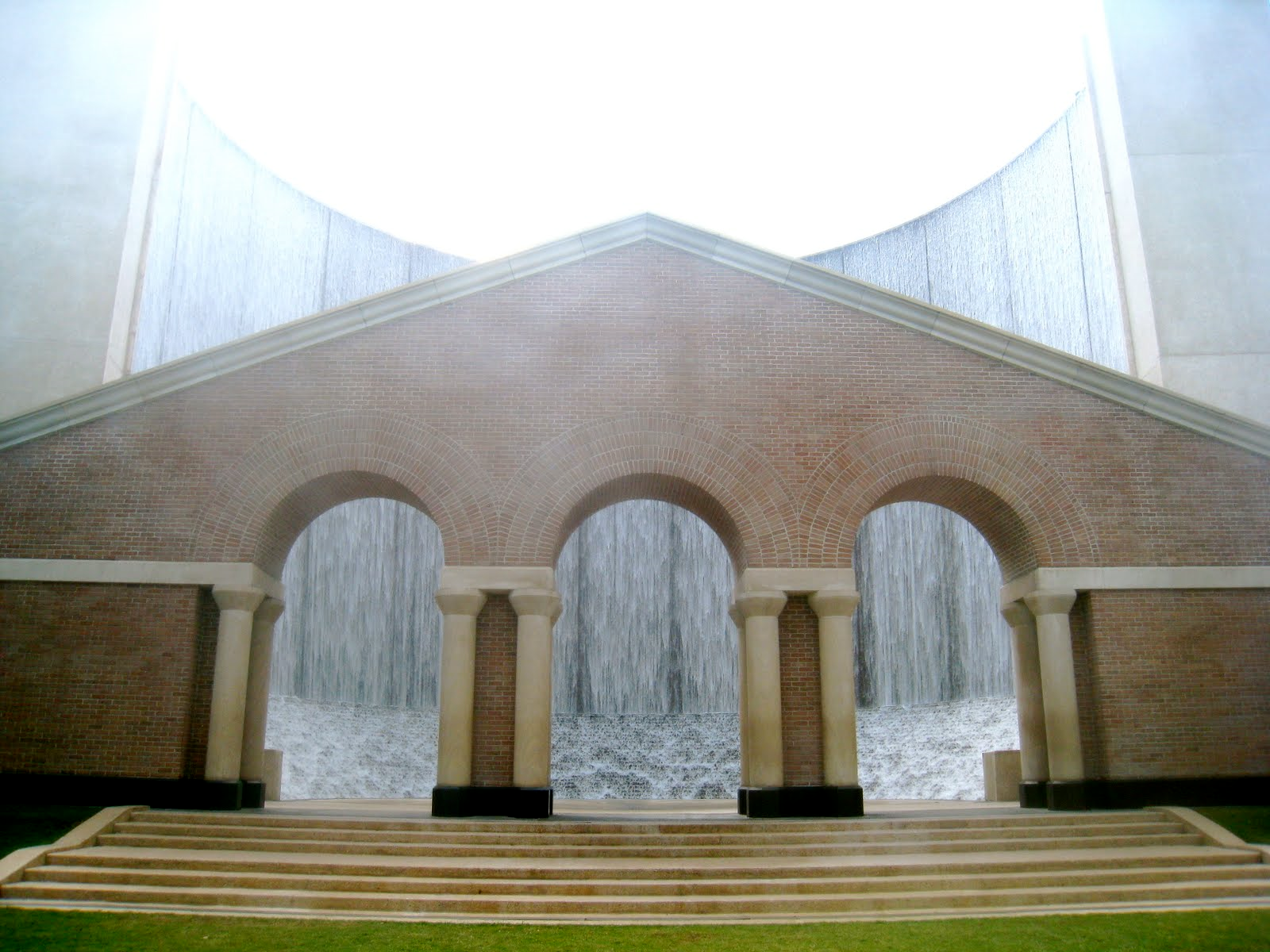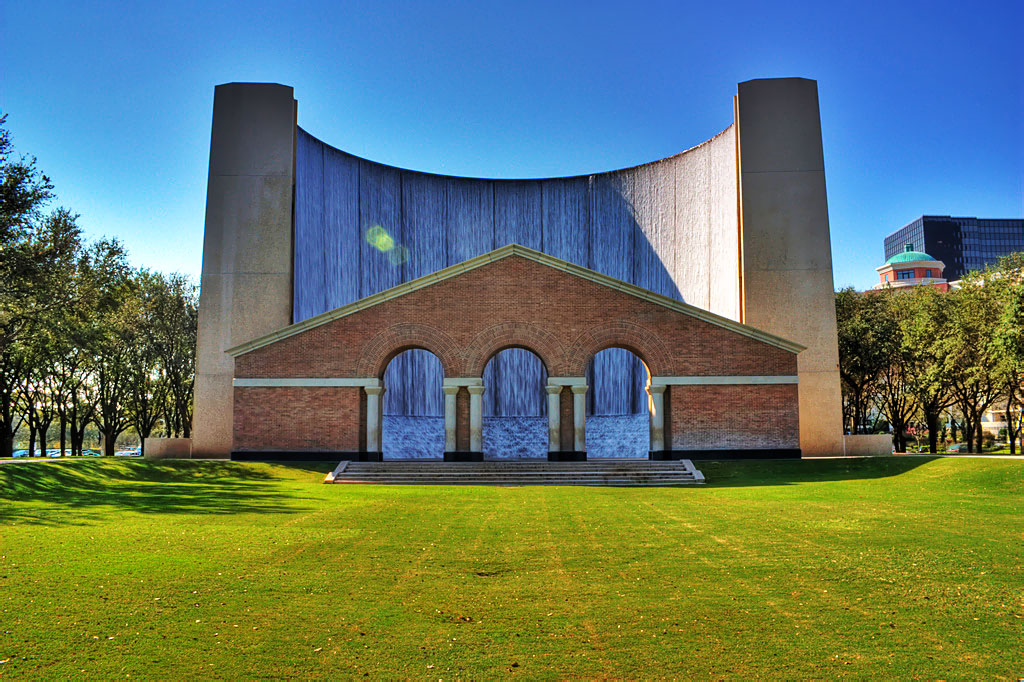Williams Waterwall is a notable fountain made of multi-stage sculptural cascades. Being the attraction spot of the Gerald D. Hines Waterwall Park, it is located in the southern part of Williams Tower, in the Uptown District of Houston. The fountain is surrounded by a beautiful park and it forms the heart of the architectural composition.
At a first glance, the Houston landmark inspires feelings of inner peace, awe, and romance. Situated among lively, old oaks in a landscaped park, the fountain possesses beauty and power of a man who invented the architectural and cultural masterpiece. The overall contemplation of the construction can provide visitors with a feeling of emotional harmony.
The splendor and elevated atmosphere of the place owns to its creator, a Pritzker Prize winner Philip Johnson, as well as its developer Gerald Hines. The architect is recognized as the America’s famous figure that managed to deliver genius designs and sculptures (Welch XIX).
Though the new architecture was very compelling due to its abstract language and clear structure, Johnson still strived to attach his masterpieces to functional domain (Welch 9). In addition, Johnson’s personal response to the art and design would create controversies enriching his future creative work.
The combination of reality and artistic vision is a necessary condition for enriching the image with various values. According to Berger, “…when an image is presented as a work of art, the way people look at it is affected by a whole series of learnt assumptions about art” (11). Indeed, while contemplating the Waterwall constructions, people resort to such concepts as beauty, genius, truth, and form – the essential features of each artistic object.
Apart from the prerequisites of the artistic object, landscape is another important element that has a potent impact on the perception of the constructions. In this respect, Berger notes, “when we ‘see’ a landscape, we situate ourselves in it.
If we ‘saw’ the art of the past, we would situate ourselves in history” (11). Thus, the object under analysis can be perceived from various angles, including cultural, spiritual, and architectural. Importantly, all of the realms are mixed to create the ideal image. While contemplating this marvelous architecture, one can hardly understand how it was constructed until you look at the building more attentively.
The Water Wall has the three archways which can be identified with the acts of life-size balance enclosed within the semicircular torrent. Like any genius sculpture, the fountain needs humans to endow it with meaning. As soon as people focus on the water spray, their heads tilt to look at the graded wall in the foot and blue sky at the top of the construction.
The height of the monument is 64 feet which equals to the 64 floors of the Tower. The Water Wall seems to be a unique construction because it skillfully combines the function of fountain and the place where people can release their negative emotions. Therefore, it looks more like a sanctuary, the sacred place for people to harmonize their emotions and strike the balance between spiritual and secular worlds. The main building of the fountain is made of brick.
The column and gamble are made of Indian Buss limestone (Spies n. p.). To build the fountain base, the developers used black granite. The Romanesque arches constructed of limestone are perfectly combined with the straightforward bricks and black granite (Spies n. p). The mixture of tender limestone and solid bricks contribute to the magnificence and impressiveness of the place. The natural landscape also complements the elevated spirit of the attraction.
Because the place is also enriched with the romance, many engaged and married couples often visit the site to catch the most unforgettable moment in their lives and take ideal photos for a family album (Nathan-Garner 121).
Many wedding parties are also held in the park because the construction represents more than just a place for enjoying and contemplating the water falling from cascades. Rather, the construction embodies the utmost feelings of humans and, therefore, the architecture seeks to reflect human ideas, experiences, and emotions.
The Water Wall is not only a remarkable landmark of the park, but an integral part of the entire architectural composition (Johnson 1). In particular, the architects states, “this horseshoe of rushing water that sites behind a proscenium arch is a welcome cool sport in often steamy Houston” (Johnson 1).
Along with Transco Tower and park landscape, the fountain is another proof of the excellence of producing architectural amenities. While contemplating the composition holistically, it is possible to understand the entire ethical and sculptural value of the spot. The Williams Waterwall can simultaneously be represented as an independent construction and as a harmonic park of the entire architectural composition.
In conclusion, the Williams Waterwall can be regarded as a genuine piece of architecture with a deep philosophical, sculptural, and historic value. While visiting this place, one can feel achieve harmony and peace of spiritual equilibrium. What is more important is that people can learn much about the object by mere contemplation because look provides visitors with the first impression about the construction.
Therefore, many people can be seen gazing at the water flowing from the upper cascades to the feet of the construction. The construction also constitutes a meaningful part of the park architectural composition, along with the Tower, which is the highest construction in Houston.
Works Cited
Berger, John. Ways of Seeing. US: Penguin Books, 1990. Print.
Johnson, Philip. Transco Tower and Park. PDF File. n. d. Web.
Nathan-Garner, Laura. Insiders’ Guide to Houston. US: Globe Pequot. 2009, Print.
Spies, Michael. Water Sculpture Makes Big Splach. Houston Chronicle Archives. 1985. Web.
Welch, Frank D. Philip Johnson & Texas. US: University of Texas Press. US: University of Texas Press, 2000. Print.
Photo 1

Photo 2

Photo 3
